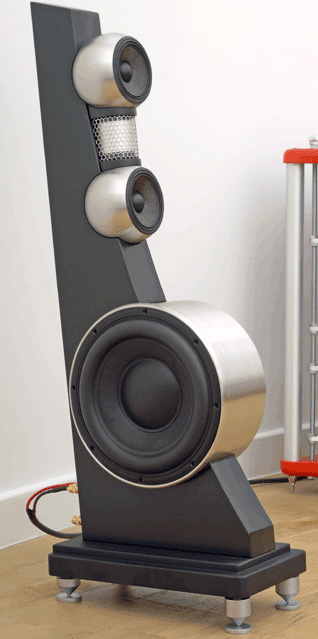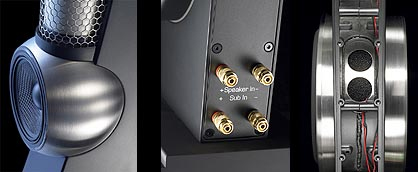You are reading the older HTML site
Positive Feedback ISSUE
16
november/december 2004
gallo
Reference 3 loudspeakers
as reviewed by Victor Chavira and Fown-Ming Tien

|
VICTOR CHAVIRA'S SYSTEM: LOUDSPEAKERS ELECTRONICS SOURCE CABLES ACCESSORIES
|
 Everything the power of the world does is done in a circle. The sky is round,
and I have heard that the earth is round like a ball, and so are the stars. The
wind, in its greatest power, whirls. Birds make their nests in circles, for
theirs is the same religion as ours. The sun comes forth and goes down again in
a circle. The moon does the same, and both are round. Even the seasons form a
great circle in their changing, and always come back again to where they were.
The life of a man is a circle from childhood to childhood, and so it is in
everything where power moves.
Black Elk, 1932
Everything the power of the world does is done in a circle. The sky is round,
and I have heard that the earth is round like a ball, and so are the stars. The
wind, in its greatest power, whirls. Birds make their nests in circles, for
theirs is the same religion as ours. The sun comes forth and goes down again in
a circle. The moon does the same, and both are round. Even the seasons form a
great circle in their changing, and always come back again to where they were.
The life of a man is a circle from childhood to childhood, and so it is in
everything where power moves.
Black Elk, 1932
The circle has been a symbol of strength and power for centuries. Likewise, the circular Gallo Reference Threes possess large musical power in a compact package. With their rigid framed hoods removed, the Reference Threes are only a few inches taller than the stands for my Marten Monks, yet despite their petite proportions, the R3s produced huge, house-filling sound.
 Most of
the credit for creating such big sound is due to Gallo's Cylindrical Dispersion
Tweeter. The CDT, which operates above 3kHz, is about the size and shape of an
eight-ounce can of tomato sauce. The motor structure within the can activates an
extremely thin conductive film around the can. Gallo states that the CDT's
lateral operating range is 300 degrees. My listening, however, indicates that
the R3 is actually an omnidirectional speaker, and should be treated as such.
For example, contrary to some pictures you may have seen, the R3 needs to be as
far away from room boundaries as possible. Otherwise, distortions stemming from
early reflections can smear the sound. Liberal use of sound absorbing material
should also be considered.
Most of
the credit for creating such big sound is due to Gallo's Cylindrical Dispersion
Tweeter. The CDT, which operates above 3kHz, is about the size and shape of an
eight-ounce can of tomato sauce. The motor structure within the can activates an
extremely thin conductive film around the can. Gallo states that the CDT's
lateral operating range is 300 degrees. My listening, however, indicates that
the R3 is actually an omnidirectional speaker, and should be treated as such.
For example, contrary to some pictures you may have seen, the R3 needs to be as
far away from room boundaries as possible. Otherwise, distortions stemming from
early reflections can smear the sound. Liberal use of sound absorbing material
should also be considered.
Understanding the CDT is critical to achieving the R3s' best performance. There is no loss of high-frequency energy when listening off axis, as with conventional speakers. For example, I could get up from my listening position to answer the phone, and the sound followed me like a shadow. The effect felt unnatural at first, but I soon came to appreciate sound in the round. Once, I accidentally pressed the balance control on the remote, but the CDT is so effective at dispersing sound that I could not determine the direction in which the sound had shifted unless I looked at the display on my MD208 receiver. Moving your head above or below the horizontal axis will result in a rolloff of high frequencies, so the speakers have taller cones under their fronts so that the tweeters' optimal plane of dispersion can be tilted toward the listener.
The CDT sounds astonishing—effortless and airy. "Astonishment" is not a word I use often. Nevertheless, that is the most accurate word to describe my reaction to music when listening to the R3s. For example, on Saturday mornings I usually listen to Duff Murphy's opera show on KUSC while preparing breakfast. This time, however, the music sounded so lifelike that I had to stop and pay attention. Two women sang an aria in harmony, with unusual purity and coherence. Each voice was uniquely rendered and emerged from free space like a floating angel's. I could sense the singers' emotions as they sang. Only a speaker with supreme resolution can project the minute inflections that singers employ to convey the glare of an angry constable or the flirtations of a beautiful lover. It took a long time to finish breakfast after listening to opera all morning.
I initially noted that the R3s' midrange was somewhat restrained compared to the unbridled enthusiasm of the CDT. This continued throughout my time with the Gallos. The trait can best be described as a gossamer-like veil across the midband. I'm not describing a tonal anomaly or frequency dip—the Gallos' timbres are right on target. I am convinced that Anthony Gallo elicited the maximum performance from his steely orbs, but the exceedingly high standard of transient speed and resolution set by the CDT is beyond the reach of the speaker's midrange drivers. I have always been drawn to the magical midrange properties of planar speakers such as Magnepans and Quads. Recent developments in driver materials and cabinet construction have all but erased the gap between box speakers and planars in terms of low coloration, imaging, and seemlessness. In fact, about eighteen months ago I sold my long-time reference Magnepan 1.6s in favor of a pair of stand-mounted Marten Monks, with their super-light ceramic drivers.
Here is an illustration. Listen to Rimsky-Korsakov's Capriccio Espagnol on the Marten Monks, and you are drawn to the warmth and harmony of violas, cellos, and horns. Listen again with the Gallo R3s, and your attention shifts to the vivid clarity of violins and swell of massed, bowed basses. Both presentations are valid and musically satisfying, yet, my personal preference is for the midband harmonic complexity and nuance that is more evident with the Martens than with the R3s. Nevertheless, harmonic complexity, nuance, and midrange refinement comes at a price. In the case of the Monks, the sum is $1800 more than the $2600 Gallos.

The R3s' bass performance was outstanding. Even without their optional Bass Augmentation Modules, the R3s are virtually full-range. The woofers can be faced to the inside or the outside, depending upon the needs of your room. I set them facing in. The woofers integrated smoothly with the midrange arrays, lending great depth and foundation. Poncho Sanchez' Conga Blue features excellent bass work from Tony Banda on electric upright bass. Usually in Latin Jazz, the bass plays a pattern of notes called a tumbao in the middle of the fingerboard. However, on the slow cha-cha "Besame Mamá," the bass plays low legato notes. The R3s' deftly reproduced the action and energy of Banda's instrument. The musician's movements were traced with great precision and timing. Gallo's S2 bass design admirably combine the speed and accuracy of a sealed bass system with the efficiency and extension of a ported unit. Unfortunately, time did not permit me to experiment with Gallo's dedicated bass amp, designed to drive the woofers' second voice coil, but even without it, the R3s painted a much deeper and broader musical picture than my Monks.
The Reference 3s were great fun in my two-channel home theater system. Their ultra-wide dispersion pattern made dialog uncommonly coherent to all viewers in the room. Sound effects were sensational on a DVD like Master and Commander, with its creaking ship sounds, swelling seas, and battle scenes. The Gallos' cast a three-dimensional soundstage that made viewers feel like they were part of the action on the screen. Israel "Cachao" Lopez' latest release, ¡Ahora Si!, comes with a DVD of the recording session. Like the Gallo R3s, the nearly 80-year-old Cachao packs big bass. Watching this living legend of Afro-Cuban music perform, compose, and direct is a pleasure, and a must-have for every fan of the genre.
I found the Gallo Reference 3s very interesting. Anthony Gallo must be commended for his steadfast adherence to his round-sound design principles. My experience suggests that the R3s belong to the di-pole, omni-directional class of speakers. I urge prospective buyers to familiarize themselves with the characteristics of this type of speaker. Anyone curious about the disproportionate amount of musical-value-for-money that Gallo has introduced to the market should have a listen to the R3s. Be prepared to ask serious questions about your prior spending. You may find that the Reference 3s are an offer you can't refuse. Victor Chavira
FOWN-MING TIEN'S SYSTEM:
LOUDSPEAKERS
ELECTRONICS
SOURCES
CABLES
ACCESSORIES
|
 Everything about the Gallo
Nucleus Reference 3 loudspeakers exudes quality. The frame is made of
steel. The binding posts are large, knurled, gold-plated knobs. The spikes for
each speaker consist of a pair of longer and a pair of shorter ones. The shorter
ones go in the rear and the longer ones in the front, to control the amount of
tilt. Removing three allen bolts with the factory-supplied wrench allows the
grilles to be removed by sliding them up and over the speakers, taking care not
to break off the toggle switch on the rear of the speaker, which allows for
tweeter level adjustment of +2dB, 0dB, or –2dB depending upon your room and
listening preferences.
Everything about the Gallo
Nucleus Reference 3 loudspeakers exudes quality. The frame is made of
steel. The binding posts are large, knurled, gold-plated knobs. The spikes for
each speaker consist of a pair of longer and a pair of shorter ones. The shorter
ones go in the rear and the longer ones in the front, to control the amount of
tilt. Removing three allen bolts with the factory-supplied wrench allows the
grilles to be removed by sliding them up and over the speakers, taking care not
to break off the toggle switch on the rear of the speaker, which allows for
tweeter level adjustment of +2dB, 0dB, or –2dB depending upon your room and
listening preferences.

Although there are dual binding posts, the Reference 3s are not designed to be conventionally bi-wired or bi-amped. The top pair of binding posts is labeled "Speaker In" and accepts a full-range signal, while the lower pair of posts connects to the 10-inch woofer's secondary voice coil, which is designed to work with the optional Gallo Reference 3 SA power amplifier. Gallo claims that the SA amp extends bass performance down to 22Hz, but unfortunately, the amp was not available for this review. In the absence of the optional amp, Gallo claims extension down to 34Hz and up to 50 kHz (+/- 3dB). With an average sensitivity rating of 88dB per watt and a nominal impedance of 8 ohms, these speakers are not difficult to drive. The driver complement consists of a CDT tweeter capable of 300 degrees of dispersion, sandwiched between dual 4-inch carbon fiber midrange drivers housed in the unique globes characteristic of Gallo speakers. These drivers are mounted to a rectangular post approximately three to four inches above the side-firing woofer. Without the grilles, the Nucleus Ref3s look positively modernistic. While the styling drew mixed opinions, there was no question that they caught the attention of every person who set foot in my home. That's what I call making a strong statement!
I initially set up the speakers about 18 inches from the back wall with no toe-in. The first thing I noticed was how much clear, extended, and airy the highs sounded compared to my speakers. On Ray Montford's Shed Your Skin, each guitar note was clearly articulated, and the airiness and added transparency seemed to suspend the notes in the air. I have never had any problems with the highs of my Onix Reference 1 monitors, but the Reference3s' were clearly better. Next I played Pinchas Zukerman's performance of Haydn's Violin Concerto and Symphony No. 22. The violin had an intoxicating combination of sweetness and clarity that I had never experienced before, and something I could not get enough of. I played the disc two more times! Switching back to my monitors left me desiring the highs of the Gallos. Often, speakers as detailed and revealing as these can sound overly bright and exhibit harshness and glare, but to my amazement the Gallos were buttery smooth.
To evaluate their midrange performance, I moved onto to some Josh Groban, Andrea Bocelli, and Diana Krall tracks. Suddenly the Gallos lost the intoxicating sound they had delivered just a minute before. All three voices were leaner, drier, and more analytical than I prefer, as I tend to like a full-bodied, warm, and lush midrange. Pulling the speakers about 3 feet from the rear wall and toeing them in about 5 or 10 degrees slightly improved the mids, and also helped reduce the boominess of the bass. Although my monitors extend to 42Hz compared to the Gallos' 34Hz, their bass is tighter and delivers more leading-edge attack. After experimenting with the placement of the Gallos, including facing the woofers both inward and outward, I preferred them firing outward.
I was using some very neutral Eichmann eXpress6 speaker cables, so decided to try some warmer sounding Onix Statement cables, which helped the Gallos take another step in the right direction, although the midrange was still leaner than I preferred. Assuming that a tube amp would further warm the sound of the Gallos and make vocals more lush, I brought out the Onix H34 integrated amp. As I'd guessed, the H34 improved the mids. Sarah McLachlan's Mirrorball was breathtaking. The highs were incredibly detailed, yet smooth. High-frequency distortion was nonexistent, and I found myself listening at over 100dB without realizing it. Even at this volume, there was no hint of distortion. These speakers can put out some serious volume!
Regardless of their placement, I was unable to get the Gallos to deliver the type of bass that I am accustomed to hearing in my room. Although their bass was not bad by any stretch of the imagination, I supplement my monitors with a subwoofer that produces clean, dynamic, and tight bass down to the mid-20Hz region. Few speakers in the Gallos' price range can match my system in bass slam, dynamics, and articulation. The Gallos' published low-frequency extension of –3dB at 34Hz is about right. I have measured my monitors at their claimed extension of –3dB at 42Hz, and the Gallos did drop a bit lower. Their imaging was admirable, but not quite as precise as that of my monitors, and I attributed this to the wider dispersion pattern of the Gallo tweeters. Their soundstage was wide and deep, and they did not draw attention to themselves.
The Gallo Nucleus Reference 3 loudspeakers deliver a lot of performance for the money, especially given their ultra-transparent and airy highs. Their treble performance is up there with some of the best speakers I have heard. If you are in the market for a pair of speakers in the $2-3000 range, you should definitely add these to your audition list, especially if you prefer neutral speakers and enjoy listening at loud volumes. Gallo may just have a winner on their hands! Fown Ming-Tien
Danny Kaey will be offering a third opinion next month.
Reference 3 loudspeakers
Retail: $2600 pair
Anthony Gallo Acoustics
web address: www.roundsound.com
